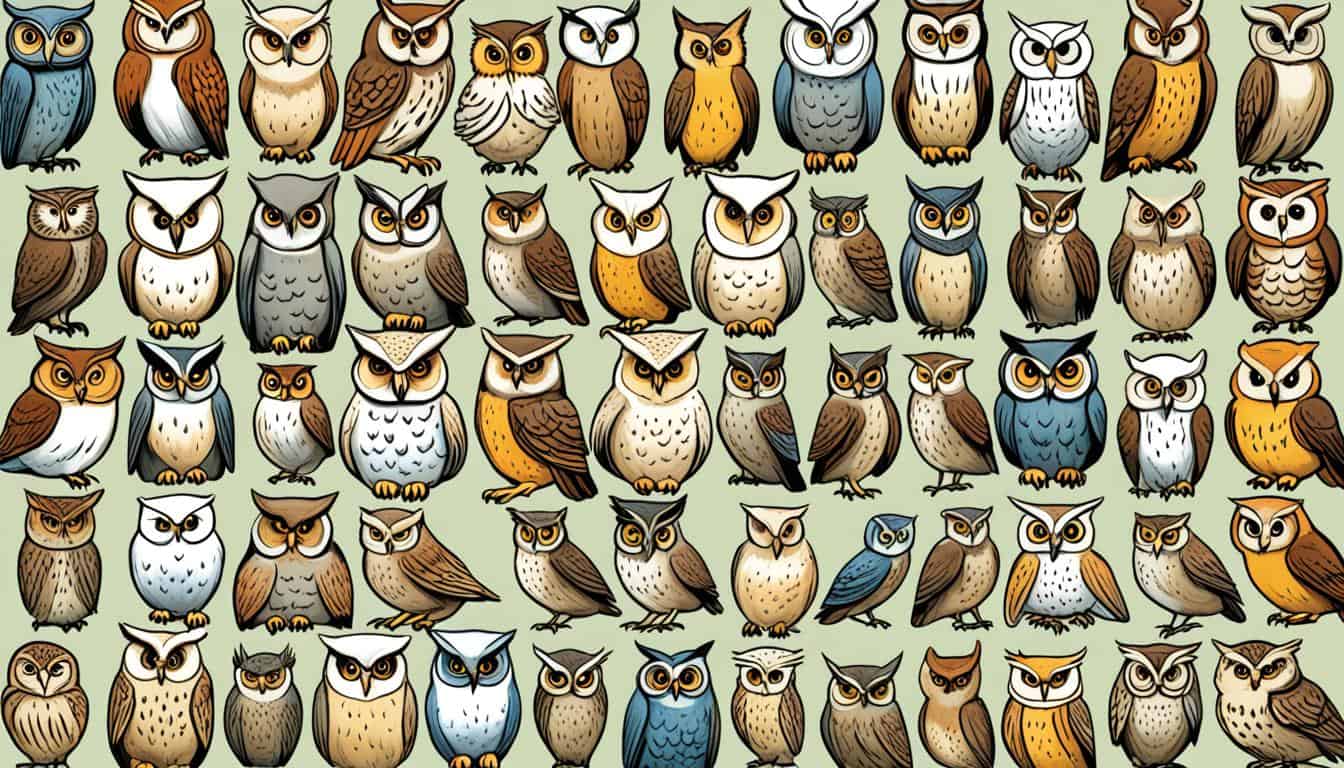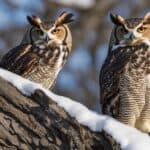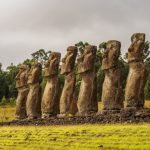Have you ever wondered how you can tell one type of owl from another just by a glance or a vocalization?
In the United States, there are 19 unique owl species. Ranging from the small Elf Owl to the big Great Gray Owl, each type is different. They differ in where they live, their sounds, and their habits. But telling them apart is hard because they are rare and don’t show themselves often.
Despite this, knowing the different owl species is important. Not only for people who love owls but also for saving them. Many owls are losing their homes and are fewer in number because of this. Are you interested in learning more about these night-time hunters? Would you like to get better at knowing and admiring them in the wild?
Introduction to Owl Identification in the United States
Have you ever tried to tell one owl from another in America? It’s important to look for specific signs like ear tufts, size, and colors. These help you figure out which owl is which. Owls live in all kinds of places, from wide-open grasslands to dense forests. And even in cities, you might spot them. Each environment offers a different puzzle for identification.
American owls are in danger due to things like cutting down forests and harmful chemicals. So, knowing about their homes and what they look like is super important. Here’s a table that shows what to look for in different owls:
| Characteristic | Description |
|---|---|
| Ear Tufts | Presence or absence, shape, and size can help differentiate between species. |
| Size | Varies significantly; from the small Elf Owl to the large Great Horned Owl. |
| Eye and Bill Color | Eye color ranges from yellow to dark brown; bill color also varies, providing clues. |
| Plumage | Color and patterns can be distinctive; e.g., snowy white of the Snowy Owl vs. the mottled gray-brown of the Barred Owl. |
If you want to help protect these amazing birds, learning about them is the first step. Knowing each owl’s unique features is fun and heroic. It helps the efforts to save them.
Key Characteristics for Owl Identification
Spotting different owl species means looking at special owl traits. Traits like ear tufts, size, eye and bill color, and plumage color help tell owls apart. We’ll take a close look at each of these traits.
Ear Tufts
Some owls stand out because of their ear tufts. The Great Horned Owl, for example, is known by its large tufts. These tufts make the owl look more fearsome. They also help it hide.
Size
Owl size is very different between species. From the tiny Elf Owl to the large Great Gray Owl, owls vary a lot. Knowing an owl’s size can sometimes tell you what kind of owl it is.
Eye and Bill Color
The color of an owl’s eyes and bill can also help with identification. For instance, the Barn Owl has dark eyes, but the Snowy Owl’s eyes are bright yellow. The bill can be different colors too, like yellow or dark brown.
Plumage Color
Some owls have special colors and patterns on their feathers. For example, the Barred Owl has barred patterns, while the Screech Owl has mottled feathers like tree bark. Looking at a owl’s feather colors is important for ID.
| Characteristic | Description | Example Species |
|---|---|---|
| Ear Tufts | Prominent tufts on head | Great Horned Owl |
| Size | Range from small to large | Elf Owl, Great Gray Owl |
| Eye Color | Varies from yellow to dark | Snowy Owl, Barn Owl |
| Plumage Color | Distinct patterns and colors | Barred Owl, Screech Owl |
How do you distinguish between different types of owls in the USA?
Different types of owls in the USA can be told apart in a few ways. Notably, their size, ear tufts, and the colors on their feathers stand out. It’s important to notice these to correctly identify them.
Owls vary greatly in size, like the small Elf Owl and the big Great Horned Owl. Looking at an owl’s ear tufts can also help you know which kind it is. Some owls have obvious tufts while others don’t. Coloration, including feather patterns, also gives clues.
Where you spot these owls also helps tell them apart. For instance, the Burrowing Owl lives in open fields, while the Northern Spotted Owl loves thick forests.
Owls have distinct sounds that can be useful for identification. Learning their different calls, like the Great Horned Owl’s hoots, the Barn Owl’s screeches, and the Eastern Screech-Owl’s whinnies, can be a big help.
| Characteristic | Description | Examples |
|---|---|---|
| Size | Varies from small to large | Elf Owl (small), Great Horned Owl (large) |
| Ear Tufts | Presence or absence | Great Horned Owl (prominent), Barn Owl (none) |
| Coloration | Distinct feather patterns and colors | Barred Owl (striped), Snowy Owl (white) |
| Habitat | Preferred environment for living | Burrowing Owl (fields), Northern Spotted Owl (forests) |
| Vocalizations | Unique calls and sounds | Great Horned Owl (hoots), Barn Owl (screeches) |
Size, ear tufts, coloration, where they live, and the sounds they make are all important. They help us understand and enjoy these amazing birds more.
Habitats of American Owls
American owls live in a variety of places. This includes boreal forests, mixed woodlands, grasslands, and deserts. Knowing about these different habitats helps us understand where owls live and why.
Some owls are very adaptable. For example, the Barn Owl lives in many different places, including the countryside and cities. But the Burrowing Owl needs open spaces like grasslands and deserts to dig its burrows.
The kinds of places American owls like can be very different:
- Boreal and Mixed Forests: Owls like the Northern Hawk Owl and Great Gray Owl live in these cool, dense forests.
- Grasslands: Burrowing Owls are at home in these wide open spaces.
- Deserts: The Elf Owl has made the dry, open deserts its own special place.
These points show the many kinds of owl habitats in the USA. It reveals the important role their homes play in their lives. The Barn Owl’s ability to live in various places is an interesting point. It shows us how diverse American owl habitats really are.
Recognizing Owl Calls and Vocalizations
It’s key to know owl sounds to tell owl species apart, especially at night. This guide will teach you to recognize different owl calls, like hoots, screeches, and whinnies. Each owl type has unique calls, helping you spot them in the dark.
Hoots
Hoots are often associated with owls for good reason. The Great Horned Owl is known for its deep hoots. You can often hear these echoing at night. They use hoots for many reasons, like claiming their area or finding a mate. So, watch out for these sounds when you’re outside at night. They could signal a nearby owl.
Screeches
The Barn Owl, on the other hand, lets out high, eerie screeches. These calls can chill you to the bone. You usually hear them more during the breeding season, as that’s when they talk the most. Getting to know these screeches will help you spot a Barn Owl. This is because they stand out as different from many other owls’ calls.
Whinnies and Burrows
But not all owls hoot or screech. Take the Eastern Screech-Owl; it makes whinny sounds, like a horse. Then there’s the Burrowing Owl, which sounds like it’s chattering or cooing. Knowing these peculiar sounds helps you identify different owl types. This can be really helpful when you can’t see the owl but can hear it.
Owls with Unique Hunting Behaviors
Owls in the United States have special ways of hunting. These methods help them get food in their own habitats. Learning about these ways can make you admire these birds more and help you tell them apart.
Owls show unique ways of hunting like sitting and then jumping to catch their prey, a technique common in forest areas. They also use a flying low technique, called quartering, which is useful in more open spaces.
Sitting high up and then suddenly coming down, as the Barred Owl does, shows their skill. They are quiet and have sharp ears, perfect for the dark woods. On the other hand, owls like the Short-eared Owl fly low over fields. They do this to find small animals with their sharp eyes and good hearing.
How an owl hunts shows a lot about where it lives. The Burrowing Owl, for example, likes daylight more. It chases prey on the ground thanks to its long legs.
- Great Horned Owl: Uses different tactics, like sitting and then jumping, and can even swim.
- Snowy Owl: Hunts a lot during the day to make the most of the almost constant daylight in its home.
- Barn Owl: Known for its unnoticeable flight, it mostly catches prey by sitting and then jumping.
- Eastern Screech-Owl: Prefers to wait and hide, surprising its prey at the best moment.
Studying owl ways of hunting lets you see how smart they are for their survival. Whether it’s being quiet on a branch or flying low in the fields, each way shows the owl’s skills and how well they fit in their homes.
Understanding Owl Habitats and Territories
Owls are very good at living in different places that meet their needs. They choose their spaces for nesting and hunting. These places serve as homes that are both safe and have what they need.
Forest Owls
Forest owls find their perfect spots in thick woods. Places with many trees are great for hiding and looking for food for owls like Barred Owls and Northern Saw-whet Owls. You can find these hidden owls by knowing about their favorite spots in the forest.
Open-Field Owls
Open-field owls, like the Short-eared Owl, choose open areas like grasslands. Here, they can see their prey clearly and have many chances to hunt. These owls fly low over fields to look for small animals. Knowing they like open spaces helps when trying to see them.
Urban and Suburban Owls
Owls also live near people, in places like cities and suburbs. The Eastern Screech-Owl is a good example. It uses urban parks and backyards for its home. These owls are very good at hiding, making it important to know where to look in cities for them.
Spotting Owls by Size: From Tiny to Giant
When talking about identifying owls by size, their various sizes are key. The Elf Owl, quite small, is known as one of the tiniest owl species. In comparison, the Great Gray Owl boasts a large wingspan. This makes the size of owls very important for telling them apart.
The size of owls varies a lot. It shows differences in where they live and how they act. The small Elf Owl, only 5 to 6 inches, is great in the desert. In contrast, the Great Gray Owl, up to 33 inches, likes the big forests up north. This lets them hunt in vast areas.
To help with identifying owls by size, focus on some key types. Here we show their average sizes and favorite places:
| Owl Species | Average Size | Habitat |
|---|---|---|
| Elf Owl | 5 to 6 inches | Deserts and Dry Forests |
| Eastern Screech-Owl | 6 to 10 inches | Woodlands and Suburbs |
| Great Horned Owl | 18 to 25 inches | Forests, Swamps, and Urban Areas |
| Great Gray Owl | 24 to 33 inches | Boreal and Mixed Forests |
Identification of Common Owl Species in the USA
In the United States, you can find many unique owl species. Their distinct features and behaviors make for great bird-watching. Knowing these differences also helps in bird conservation.
Barn Owls
Barn Owls stand out with their heart-shaped faces and hunting skills. They often live in open areas and barns. Their sharp eyesight and keen hearing mean they can hunt well, even in the dark.
Great Horned Owls
Great Horned Owls are known for their ear tufts, making them very visible. They live in a variety of places and eat animals like mammals, birds, and reptiles.
Barred Owls
Barred Owls are recognized by their call, which sounds like “Who cooks for you? Who cooks for you-all?” They prefer mature forests and swamps. Their brown and white feathers help them blend in.

Eastern and Western Screech-Owls
Easier to identify, the Eastern and Western Screech-Owls are small. The Eastern Screech-Owl makes a descending whinny sound, and the Western Screech-Owl whistles quickly. Despite their size, they are skilled at hunting.
| Species | Distinctive Features | Preferred Habitat |
|---|---|---|
| Barn Owls | Heart-shaped face, excellent vision and hearing | Open fields, barns |
| Great Horned Owls | Prominent ear tufts, adaptable diet | Various habitats including forests and urban areas |
| Barred Owls | Distinctive hooting call, barred plumage | Mature forests, swamps |
| Eastern and Western Screech-Owls | Small size, distinct vocalizations | Forests, suburban areas |
Tips for Observing and Identifying Nocturnal Owls
Watching nocturnal owls is both thrilling and hard. It takes patience and knowledge. Learning owl calls can make them come closer. This is more effective during their breeding season.
To see them, go out at dawn or dusk. These are peak activity times for owls. Also, learn to identify different owl species by their calls. Knowing where they live helps too.
Here’s a summary of how to watch nocturnal owls well:
- Study owl calls to find and name different owl types.
- Go out at dawn and dusk, their most active times, to see more.
- Be patient and walk quietly to not startle them.
- Know where different types of owls like to be.
- Get a good red flashlight to watch without disturbing them.
Using these tips will grow your owl-watching skills. It’ll help you spot and name nocturnal owls better.
Factors Threatening Various Owl Species in the USA
Owl species in the United States are facing big challenges. Their homes are being destroyed, harming where they nest and find food. Places that are important for owls, like the Spotted Owl, are being lost as cities grow.
Pesticides are also a big problem. They can hurt the owls by making their food toxic. Owls are also being hit by cars more because they look for food near roads. The Short-eared Owl is one example of these problems, with its numbers dropping fast.
Knowing these threats is the first step to helping owls. By spreading the word and pushing for steps to protect them, you can make a real difference. Things like saving their homes, using less pesticide, and building roads that are safer for owls can help. This way, we can have more owls living healthier lives across America.
FAQ
How do you distinguish between different types of owls in the USA?
To ID owl types in the US, focus on size, ear tufts, eye and bill color. Look at their feathers too. Also, think about where they live, what they do, and the sounds they make. This all helps to know which owl is which.
How can I start with owl identification in the United States?
First, learn about the 19 owl species in the USA. Pay attention to their looks, habits, and homes. Knowing this makes telling owls apart easier.
What are the key characteristics for owl identification?
Look at things like ear tufts, size, and the colors of their eyes, bills, and feathers. These details show the differences between owl types in the US.
How do habitats influence owl identification?
Each owl likes certain places to hunt and live. Knowing their favorite spots, whether forests or city parks, guides in owl ID.
How can I recognize owl calls and vocalizations?
Owls make special sounds like hoots, screeches, and whinnies. Getting used to these calls helps pin down which owl you’re hearing.
What are some unique hunting behaviors of owls?
Watching for owls hunting is fascinating. Some sit and wait in trees, ready to pounce. Others fly low over fields. These ways of hunting tell us about their kind and their homes.
How do owl habitats and territories differ?
Some owls like dense forests. Others prefer open lands. There are even those that live near people. Knowing this helps when trying to name the owl you see.
How does the size of an owl help in its identification?
Owls in the USA range from small to very large. Keep their sizes in mind when figuring out which owl is which.
What are some common owl species in the USA and how do you identify them?
Look for Barn Owls, Great Horned Owls, Barred Owls, Eastern and Western Screech-Owls. They each have special looks and calls that make them stand out.
What tips can you provide for observing and identifying nocturnal owls?
Nighttime owl watching takes time and knowledge. Use calls to attract them. Know when they are most active. Being familiar with their sounds can help find them.
What factors threaten various owl species in the USA?
Owls in the USA are up against habitat loss, chemicals, and cars. In some places, owls like the Spotted Owl and Short-eared Owl are getting rarer. We work to keep them safe.







